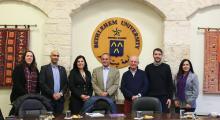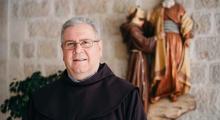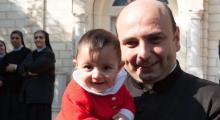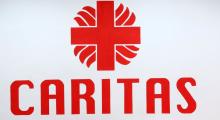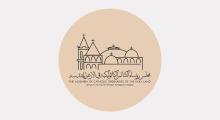Issued by the Catholic Center for Studies and Media - Jordan. Editor-in-chief Fr. Rif'at Bader - موقع أبونا abouna.org
At the end of the initiative supported by the Commissary of the Holy Land of Tuscany and Florence City Council entitled “Florence and Jerusalem”, a meeting was held to take stock of the excavations underway at the Basilica of the Holy Sepulchre on 29th April at the Marino Marini Museum in Florence.
The event aimed to reread the history of the archaeological excavations at the Holy Sepulchre, giving a voice to those in charge of the works today and yesterday, namely Prof. Francesca Romana Stasolla, of the La Sapienza University of Rome, director of the current site, and Prof. Grazia Tucci, of the University of Florence, who carried out seismic investigations and made scientific surveys between 2007 and 2011 at the same site.
The presence of Fr. Francesco Patton, Custos of the Holy Land, also a guest at the event, enriched the discussion. The Father Custos wanted to emphasize how these works have taken on an “ecumenical value” over time, representing in some way an occasion for encounter and dialogue between the Christian communities that share the same spaces in the Basilica. Concentrating on the common objective of developing the area around the Sepulchre has allowed the various Christian communities to get to know each other better and weave new brotherly relations.
The meeting was divided into a number of parts, which were moderated by the journalist Giuseppe Cafulli, a member of the Board of Directors of the Fondazione Terra Santa and editor of the magazine of the same name.
A first part of the event in Florence was on the work methods to use in such a peculiar site as that of the Holy Sepulchre, where it is always necessary to work with great caution. The archaeologists do not work on any terrain whatsoever: in loco they have to take into account and respect the particular constraints imposed by the Status Quo, which since the times of Ottoman rule, has regulated the coexistence of the different Christian communities in the holy places.
This was followed by a discussion on the scientific findings by the team of Professor Tucci (between 2007 and 2011) and the first archaeological evidence from the investigations by the team currently directed by Prof. Stasolla: "We are working practically night and day, in three shifts, to acquire as much scientific data as possible that is then sent to Rome where it is studied. Ours is a work of patience, because the data is studied and examined in depth before it is possible to reach any conclusions, the lecturer at Rome University explained.
In his contribution, the Father Custos recalled the importance of the mission of the friars minor in the Holy Land and in particular at the Holy Sepulchre, where the restoration works have inaugurated a new season of dialogue. According to Fr. Patton, the current excavations are also an opportunity to improve our knowledge of the Gospel, because they help us to understand the context in which Jesus physically lived. In this sense, archaeology can help us better penetrate the mystery of a God who became man and came to live in a real space, at a specific moment in the history of the world: "Archaeology can help us in this, to understand the historical and geographic context of the episodes related in the Gospels,” Fr. Francesco added.
The meeting titled, "The excavations at the Holy Sepulchre: rereading history and constructing relations” closed the Florentine exhibition on the analogies between Jerusalem and Florence, which lasted ten days.Through meetings and video installations, visitors were able to immerse themselves in an experience intended to offer a common vision of peace between the two cities, which both have a history of faith, culture and beauty.









